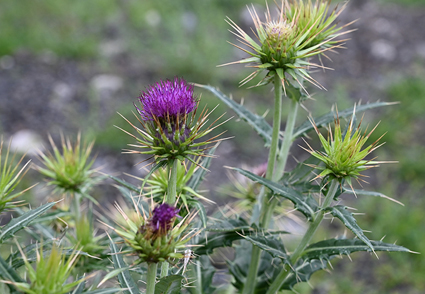Abstract
We apply both morphology and molecular systematics approaches to resolve the dispute over the generic affiliation of Lamyropsis macracantha. Based on observations of herbarium specimens (including type material) and living plants, as well as phylogenetic analyses based on ITS/ETS sequences, we demonstrate that Lamyropsis macracantha is a member of Cirsium.
References
- Charadze, A.L. (1963) Cirsium Mill. In: Bobrov, E.G. & Czerepanov, S.K. (Eds.) Flora of the USSR, vol. 28. Academy of Sciences of the USSR, Moscow & Leningrad, pp. 51–215. [In Russian]
- Davis, P.H. (1975) Cirsium Mill. In: Davis, P.H. (Ed.) Flora of Turkey and the East Aegean Islands, vol. 5. Edinburgh University Press, Edinburgh, pp. 370–412.
- Dittrich, M. (1971) Lamyropsis (Charadze) Dittrich—Zur Frucht- und Blütenmorphologie einer kritichen Gruppe aus der Ptilostemon-Verwandtschaft. Candollea 26: 97–102.
- Guindon, S., Dufayard, J.F., Lefort, V., Anisimova, M., Hordijk, W. & Gascuel, O. (2010) New algorithms and methods to estimate maximum-likelihood phylogenies: assessing the performance of PhyML 3.0. Systematic Biology 59: 307–321. https://doi.org/10.1093/sysbio/syq010
- Hall, T.A. (1999) BioEdit: A user-friendly biological sequence alignment program for Windows 95/98/NT. Nucleic Acids Symposium Series 41: 95–98.
- Katoh, K. & Standley, D.M. (2013) MAFFT multiple sequence alignment software version 7: improvements in performance and usability. Molecular Biology and Evolution 30: 772–780. https://doi.org/10.1093/molbev/mst010
- Lamarck, J.B.P.A. de Monnet de (1785) Encyclopedie Methodique. Botanique, vol. 1 (2). Paris, pp. 345–752.
- Miller, P. (1754) The Gardeners Dictionary (4th ed.), corrected and enlarged, vol. 1. Printed for the author, London.
- Minh, B.Q., Nguyen, M.A. & Haeseler, A. (2013) Ultrafast approximation for phylogenetic bootstrap. Molecular Biology and Evolution 30: 1188–1195. https://doi.org/10.1093/molbev/mst024
- Nguyen, L.T., Schmidt, H.A., Haeseler, A. & Minh, B.Q. (2015) IQ-TREE: a fast and effective stochastic algorithm for estimating maximum-likelihood phylogenies. Molecular Biology and Evolution 32: 268–274. https://doi.org/10.1093/molbev/msu300
- POWO (2024) Plants of the World online. Facilitated by the Royal Botanic Gardens, Kew. Available from: http://www.plantsoftheworldonline.org/ (accessed 9 September 2024)
- Ronquist, F. & Huelsenbeck, J.P. (2003) Mrbayes 3: Bayesian phylogenetic inference under mixed models. Bioinformatics 19: 1572–1574. https://doi.org/10.1093/bioinformatics/btg180
- Schrenk, A. (1842) Novae plantarum species, nuperime D. Al. Schrenk in Songaria lectae (continuatio). Bulletin de l’Académie Impériale des Sciences de Saint-Pétersbourg 10: 353–356.
- Shen, G.M. (1999) Cirsium Mill. In: An, Z.X., Shen, G.M. & Chui, D.D. (Eds.) Flora Xinjiangensis, vol. 5. Xinjiang Science & Technology & Hygiene Publishing House, pp. 318–333. [In Chinese]
- Shi, Z. & Greuter, W. (2011) Cirsium Mill. In: Wu, Z.Y. & Raven, P.H. (Eds.) Flora of China, vols. 20–21. Science Press, Beijing & Missouri Botanical Garden Press, St. Louis, pp. 160–175.
- Shih, C. (1987) Cirsium Mill. In: Ling, Y. & Shih, C. (Eds.) Flora Reipublicae Popularis Sinicae, vol. 78 (1). Science Press, Beijing, pp. 78–135. [In Chinese]
- Tamamschian, S. (1961) Notae criticae de generis Chamaepeuce Pr. Alpin e Asia media. Zametki po Sistematike i Geografii Rastenii 22: 80–82. [In Russian]
- Trautvetter, E.R. (1873) Stirpium novarum descriptiones. Acta Horti Petropolitani 2: 471–487.
- Turland, N.J., Wiersema, J.H., Barrie, F., Greuter, W., Hawksworth, D.L., Herendeen, P.S., Knapp, S., Kusber, W.-H., Li, D.-Z., Marhold, K., May, T.W., McNeill, J., Monro, A.M., Prado, J., Price, M.J. & Smith, G.F. (Eds.) (2018) International Code of Nomenclature for algae, fungi, and plants (Shenzhen Code) adopted by the Nineteenth International Botanical Congress Shenzhen, China, July 2017. Regnum Vegetabile 159. Koeltz Botanical Books, Glashütten. https://doi.org/10.12705/Code.2018
- Moore, D.M., Tutin, T.G. & Walters, S.M. (1976) Compositae. Key to genera. In: Tutin, T.G., Heywood, V.H., Burges, N.A., Moore, D.M., Valentine, D.H., Walters, S.M. & Webb, D.A. (Eds.) Flora Europaea, vol. 4. Cambridge University Press, Cambridge, pp. 103–109.
- Zhang, D., Gao, F.L., Jakovlic, I., Zou, H., Zhang, J., Li, W.X. & Wang, G.T. (2020) PhyloSuite: an integrated and scalable desktop platform for streamlined molecular sequence data management and evolutionary phylogenetics studies. Molecular Resources 20: 348–355. https://doi.org/10.1111/1755-0998.13096


